I know it is preferred if variable names do not have spaces in them. I have a situation where I need publication-quality charts, so axes and legends need to have properly formatted labels, ie with spaces. So, for example, in development I might have variables called "Pct.On.OAC" and Age.Group, but in my final plot I need "% on OAC" and "Age Group" to appear:
'data.frame': 22 obs. of 3 variables:
$ % on OAC : Factor w/ 11 levels "0","0.1-9.9",..: 1 2 3 4 5 6 7 8 9 10 ...
$ Age Group : Factor w/ 2 levels "Aged 80 and over",..: 1 1 1 1 1 1 1 1 1 1 ...
$ Number of Practices: int 47 5 33 98 287 543 516 222 67 14 ...
But when I try to plot these:
ggplot(dt.m, aes(x=`% on OAC`,y=`Number of Practices`, fill=`Age Group`)) +
geom_bar()
)
no problem with that. But when I add a facet:
ggplot(dt.m, aes(x=`% on OAC`,y=`Number of Practices`, fill=`Age Group`)) +
geom_bar() +
facet_grid(`Age Group`~ .)
I get Error in[.data.frame(base, names(rows)) : undefined columns selected
If I change Age Group to Age.Group then it works fine, but as I said, I don't want the dot to appear in the title legend.
So my questions are:
- Is there a workaround for the problem with the facet ?
- Is there a better general approach to dealing with the problem of spaces (and other characters) in variable names when I want the final plot to include them ? I suppose I can manually overide them, but that seems like a lot of faffing around.
